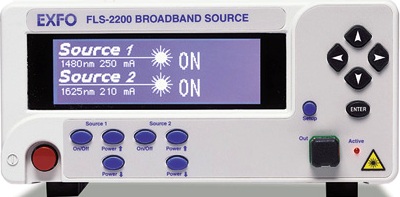
|
|
The Exfo FLS-2200 Laser Source is a high-power, SLED-based FLS-2200 Broadband Source family covers all the bands needed for telecommunications applications. It provides a broader spectral range and more spectral density in a singlemode fiber than a white light source. The highly stable FLS-2200 is ideal for broadband applications, coarse wavelength-division multiplexing (CWDM) network testing, and passive optical networks (PON) component manufacturing and testing, as well as fiber-optic sensing and spectroscopy. Two Sources, One Box for CWDM testing, the dual-SLED option, covering the S, C and L bands, enables accurate characterization of fiber links and their passive components, with a very cost-effective test setup. Use the 1300 nm/1550 nm source for dual-window couplers and for PON components. Designed for Component Testing EXFO’s FLS-2200 offers enough power along the spectrum to measure high-level insertion loss. By combining the FLS-2200 with an optical spectrum analyzer (OSA), you can efficiently qualify your components during development or perform pass/fail testing during production. Depolarization as sources are naturally polarized, it is possible to take advantage of EXFO’s M9700 and IQS-9700 Passive Depolarizers, to bring the degree of polarization to less than 5%. This is especially useful when measuring the average insertion loss or counteracting the polarization dependency of an OSA. High Spectral Density Stability is essential to ensure that the test setup produces accurate measurements, time and again. The more stable the spectrum, the less often a reference trace has to be acquired. This translates into better productivity. After a reference trace is acquired with the OSA, it can be subtracted to all subsequent traces. With no device under test (DUT) in the system, the resulting traces, centered around the averaged value, present the typical spectral fluctuations of the source. Single SLED (FLS-2200-04 and FLS-2200-23), Dual SLED (FLS-2200-SCL). Center wavelength (nm): 1610 ± 15 (FLS-2200-04), 1310 ± 20; 1550 ± 20 (FLS-2200-23), 1485 ± 15; 1570 ± 10 (FLS-2200-SCL). 3 dB spectral width (nm): > = 50 (55 typ.) (FLS-2200-04). Output power (dBm): 5 (FLS-2200-04), >=8 (FLS-2200-23), >=3.5 (FLS-2200-SCL). Minimum spectral density (dBm/nm): -20 (1565-1640 nm) (FLS-2200-04), -28 (1260-1360,1510-1590) (FLS-2200-23), -29 (1460-1625) (FLS-2200-SCL). Peak spectral density (dBm/nm): -10 (FLS-2200-04 and FLS-2200-23), -23 (FLS-2200-SCL). Total power stability (dB): 15 min ± 0.01; 8 hours ± 0.01 (FLS-2200-04), ±0.015 (FLS-2200-23 and FLS-2200-SCL)). Spectral density stability (dB): 15 min ± 0.01; 8 hours ± 0.015. Ripple (dB): 0.3. Fiber type (µm) 9/125. Size (H x W x D) 117 mm x 222 mm x 333 mm (4 5/8 in x 8 ¾ in x 13 1/8 in). Weight b 2.7 kg (5.9 lb). Temperature: Operating 0 degC to 40 degC (32 degF to 104 degF); Storage -40 degC to 70 degC (–40 degF to 158 degF). Relative humidity 0 % to 80 % non-condensing
|